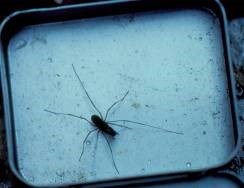Last updated: November 17, 2022
Article
Harvestman
General Description:
Harvestmen look like spiders because they have eight legs, but they are not real spiders. Instead of eight eyes, they have two eyes that look sideways. They lack silk glands and spinners, so they don’t make webs, and the body is made up of one oval segment instead of two. They have glands that produce a stinky odor. The most noticeable feature of Taracus is very large chelicerae, clawlike feeding appendages near the mouth that are often longer than the body. Many species have long legs, but not all of them do and they aren’t the same as the kind of spider that is known as “daddy longlegs.”
Behavior and Feeding:
Taracus are omnivorous scavengers, eating dead animal matter, plant material, and fungi. They can also catch and eat small insects, and some forest species are fierce enough to prey on snails, cracking their shells with the chelicerae.
The Cave Obligate Lifestyle:
Cave obligate species complete their life cycle entirely in the cave environment and are called troglobites. Their adaptations can include loss or reduction in eyes and pigmentation, elongation of appendages, and increased sensory structures. They may also have longer lifespans and lower metabolism.
What is the common name of Taracus silvestrii?
It doesn’t have one. This is one of the many organisms in the world that is recognized by science as a distinct entity, but that is not familiar enough to have its own name for daily use. There are 3500 known species of harvestmen. That would be a lot of names to remember.
Where to see it in the Klamath Parks:
This species has been recorded in the Main Cave at Oregon Caves National Monument.

John Roth, NPS
Habitat:
As a cave obligate species, it only lives deep in caves. The cave environment is characterized by the absence of light and food scarcity.
Distribution:
T. silvestrii is endemic to Oregon. The genus is relatively small, with fewer than twenty species, and has a holarctic distribution which includes the northern parts of the Old and New Worlds.
Status:
T. silvestrii does not have a state status ranking, but it is listed as critically imperiled on the national and global levels by Natureserve, a conservation database. Cave obligate species are often at greater risk of population loss and extinction because of their small population size, lower reproductive rates, and highly specialized habitat needs. Endemic species are also at greater risk because of their restricted distribution.
Additional Information:
Encyclopedia of Caves. David C. Culver and William B. White, eds. 2005.
Prepared by:
NPS Klamath Inventory & Monitoring Network
Southern Oregon University
1250 Siskiyou Blvd
Ashland, OR 97520
Featured Creature Edition: January 2006
